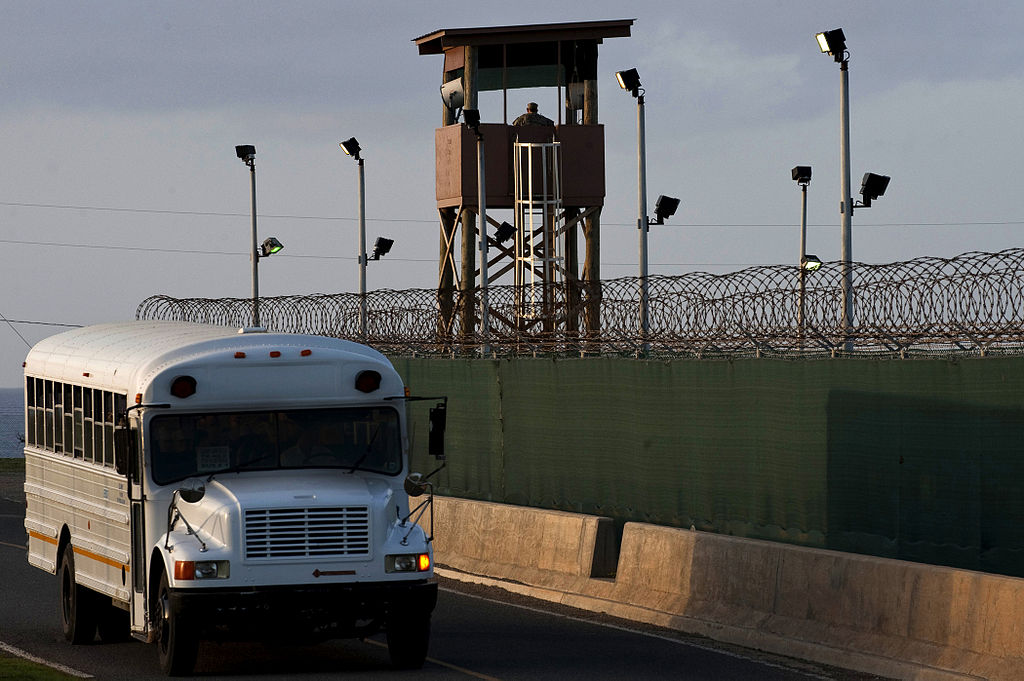Summary: Briefs and Oral Argument in Dalmazzi v. US
On Tuesday, the Supreme Court heard oral argument in Dalmazzi v. United States.

Published by The Lawfare Institute
in Cooperation With

On Tuesday, the Supreme Court heard oral argument in Dalmazzi v. United States. The case revolves around an issue of statutory interpretation—namely, whether four judges were lawfully appointed to the Court of Military Commission Review (CMCR) in light of a federal statute that generally prohibits military officers from simultaneously holding certain “civil offices.” But Dalmazzi also implicates fascinating constitutional questions as to the separation of powers and the proper scope of the Supreme Court’s Article III jurisdiction. This post provides background on the case, an overview of its key issues, and highlights from Tuesday’s oral arguments.
Background: The CMCR and Dalmazzi, Cox, and Ortiz
The CMCR oversees the Guantanamo Bay military commissions and functions as the intermediate appellate court between the commissions and the U.S. Court of Appeals for the D.C. Circuit. Using its Article I powers to regulate the armed forces, Congress created the CMCR under the Military Commissions Act of 2006 (MCA) as part of its response to the Supreme Court’s decision in Hamdan v. Rumsfeld. The MCA also gave the D.C. Circuit supervisory control over the military commissions and the CMCR.
Following the Military Commissions Act of 2009, there are two ways to become a judge on the CMCR. First, the defense secretary may “assign persons who are appellate military judges to be judges on the [CMCR],” provided such person is already a “commissioned officer of the armed forces.” Alternatively, the president may “appoint, by and with the advice and consent of the Senate, additional judges” who need not be military officers. While civilians are permitted to serve on the CMCR, its judges have mostly been active-duty military officers concurrently serving as appellate judges on military courts of criminal appeals.
In 2014, Guantanamo Bay detainee Abd Al-Rahim Hussein Muhammed al-Nashiri petitioned the D.C. Circuit for a writ of mandamus to disqualify the military judges hearing an interlocutory appeal on the ground that the judges’ service on the CMCR violated the appointments clause. CMCR judgeships, reasoned al-Nashiri, were principal officer positions under Article I and therefore required appointment by the president with the advice and consent of the Senate. At the time, the secretary of defense has assigned those judges to the CMCR. A D.C. Circuit panel found that the matter did not meet the conditions for mandamus, but noted the government could avoid the constitutional question entirely by having the president appoint the judges and the Senate to confirm them. President Barack Obama did so as a prophylactic measure.
Those appointments gave rise to the litigation now before the Supreme Court. Dalmazzi consolidates with two other cases—Cox v. United States and Ortiz v. United States—that, in total, cover eight servicemembers who were convicted before courts-martial and whose appeals were heard before either the Army or Air Force Court of Criminal Appeals (CCA). (The offenses at issue varied from wrongful use of a controlled substance, to sexual misconduct, to possession of child pornography.) In each instance, at least one of the judges that President Obama appointed to the CMCR sat on the CCA panel. The petitioners are now challenging the validity of those CCA decisions on the ground that those judges’ simultaneous service on a CCA and the CMCR violated 10 U.S.C. §973(b)(2)(A)(ii)’s so-called “dual-officeholder ban.” The statute, in short, prohibits active-duty military officers from also holding certain “civil office[s]” without authorization by Congress. As such, petitioners seek respective re-hearings before new CCA panels because their previous panels were composed in violation of law.
Before turning to the main issues, it’s worth noting that two of the three cases—Cox and Dalmazzi—face an additional jurisdictional hurdle. The Supreme Court only has jurisdiction over decisions by the Court of Appeals of the Armed Forces (CAAF)—an Article I court that sits above the CCAs as the final appellate court in the service branches—when the CAAF has “granted a petition for review.” But the CAAF vacated and denied its initial orders granting review in each of the underlying cases at issue in Cox and Dalmazzi. As such, the government argues that the Supreme Court lacks jurisdiction over the cases because there is no longer any CAAF decision to review. The petitioners counter that the CAAF’s initial decision to grant review of their cases satisfied the statute, giving the Supreme Court jurisdiction. No such issue exists for Ortiz, and the government concedes that the Court should reach that case’s merits.
Merits: The Dual-Officeholder Ban and Related Constitutional Questions
The core question in Dalmazzi is whether the president’s appointment of the CCA judges to the CMCR violated Section 973(b).
The statute provides that a military officer cannot hold certain “civil office[s],” including positions that “require ... an appointment by the President by and with the advice and consent of the Senate” unless “otherwise authorized by law.” There are thus two main points of contention critical to understanding the case. First, is a CMCR judgeship a “civil office” covered by the statue? And second, if so, has Congress otherwise authorized such appointment by law?
Petitioners first maintain that CMCR judges hold a “civil office.” Though the statute does not define the term, petitioners argue the law’s purpose and congressional practice jointly dictate that “civil office” should be construed broadly. In that light, petitioners argue that CMCR judges “easily” fall under the statute: Congress created statutory positions under Article I, such positions can be (and are) held by civilians, and CMCR judges’ duties involve “a clear exercise of the sovereign power of the United States.” Accordingly, even though the CMCR has jurisdiction over military matters, petitioners argue that its judges are often primarily tasked with deciding “whether military commissions complied with domestic law established by Congress, including domestic-law criminal offenses defined in the MCA.”
The government rejects the notion that CMCR judgeships are “civil offices,” arguing that the term is left undefined and should be given its ordinary meaning: “non-military.” Because “review of military commissions, like review of courts-martial, is a military function,” the positions are not covered by the statute. Both parties agree that CCA judges do not hold civil offices because the “role of a military judge is germane to that of a military officer.” According to the government, the same logic applies to CMCR judges who perform a substantially similar role. This view gains support from the fact that military commissions are limited to “alien unprivileged belligerent[s]” and oversee “offenses that have traditionally been triable under the law of war or otherwise triable by military commission.”
At least one wrinkle merits unpacking. Petitioners concede they would not have a case under the dual-officeholding ban if the CMCR judges were simply assigned to the position—recall that the judges were appointed following the al-Nashiri litigation—although there would be an open appointments clause question. As Steve Vladeck explained during oral argument, advocating for the petitioners: “When military officers are assigned, whether to the CCAs or to the CMCR, they don’t hold a second office in the first place.” To bridge this gap, petitioners argue that the 2009 MCA amendments—which, again, bifurcated the way that individuals could become CMCR judges—thus created two positions. (A useful analogy, employed in the brief, is the distinction between the Chief Justice of the United States and Associate Justices of the Supreme Court.) In doing so, Congress made a “civil office” that could be filled only by appointment. The textual hook for this argument is that the appointment route contemplates “additional judges” while the assignment route only pertains to “military officers.” This theory holds particular importance for the second question at issue in the case: Whether Congress expressly authorized military officers to hold CMCR judgeships.
The government contends it did: Even if CMCR judges hold “civil offices” for the purposes of Section 973(b), military officers are “authorized by law” to serve as CMCR judges. According to the government, Congress created a single office when it created the CMCR and provided for judges to serve on the body. In other words, a judge who is appointed to the CMCR and a judge who is assigned to the CMCR both hold the same office. Therefore, because the MCA permits the secretary of defense to assign active appellate military judges who are commissioned officers to be judges on the CMCR, Congress authorized military officers to hold this position, thereby satisfying Section 973(b). This authorization, reasons the government, applies in equal force to CMCR judges without regard to whether assigned to the position by the secretary of defense or appointed by the president.
Petitioners, by contrast, deny that the issue is so simple. Drawing on Supreme Court precedent that has drawn meaningful distinctions between “assigned” positions and “appointed” ones, petitioners maintain that one cannot omit congressional differentiations in order to claim express statutory authorization. And because “military officers” are only mentioned when it comes to those judges assigned rather than those appointed, the MCA cannot be read as giving clear authorization for the sort of appointments at issue here.
As a means of choosing between these two statutory constructions, petitioners raise two constitutional issues that caution in favor of their reading. First, the government’s view of the statute would permit an individual to simultaneously hold an inferior and principal officer position within the executive branch. Such a reading might produce a “functional incompatibility” in violation of the appointments clause. For instance, if sitting on a panel with inferior officers, such persons “may well be unduly influenced by—or unduly seek to influence—his principal office.” Second, because CMCR judges appointed by the president may only be removed for cause, the government’s reading—which would allow them to be active-duty military officers—may create an inappropriate constraint on the president’s authority as Commander in Chief.
The government rejects that either open-ended constitutional issue should have bearing on the statutory question. First, there is no legal basis for “such ill-defined ‘incompatibility’ or ‘incongruity’ limits” on the appointments clause and no grounded reason why an individual cannot serve in two distinct offices that happen to be principal and inferior, respectively. Second, the government points out that petitioners’ argument about the president’s commander-in-chief authority rests on a “mistaken premise” that incorrectly ignores certain reassignment provisions.
Lastly, there remains a secondary question as to what happens if the petitioners are right: Assuming the appointments were unlawful, what’s the appropriate remedy? Petitioners say that Section 973(b), even after amendment in 1983, “codified the common-law doctrine of incompatibility, under which ‘an office holder was not ineligible to appointment or election to another incompatible office, but acceptance of the latter vacated the former.’” Therefore, the CCA panels were invalidly constituted, and petitioners should be entitled to re-hearings. The government reasons that such a reading ignores the significance of the 1983 amendments’ “broad savings clause,” which states that Section 973(b) may not be “construed to invalidate any action undertaken by an officer in furtherance of assigned official duties.” This, according to the government, precludes the Supreme Court from disturbing the CCA panels’ judgments.
Marbury and Article III Jurisdiction
The Supreme Court also received briefing from University of Virginia Professor Aditya Bamzai, who advocated that neither party is correct. Instead, drawing on Marbury v. Madison, Bamzai argued that the Supreme Court lacks jurisdiction to hear any of the cases. As noted above, Dalmazzi reached the Supreme Court after the justices issued a writ of certiorari to the CAAF as provided for in 28 U.S.C § 1259. But according to Bamzai, this statute is unconstitutional because it expands the court’s original jurisdiction in violation of Marbury.
In particular, Bamzai argues CAAF is labeled a “court” by statute, but it is not one for the purposes of establishing Article III appellate jurisdiction: It is purely an exercise of “executive power” rather than “judicial power.” As such, without some intervening exercise of “judicial power” by some court, there is no decision to be appealed as constitutionally understood. Without this step, the Supreme Court cannot hear the case unless the Constitution gives it original jurisdiction—and it clearly does not do so here. In light of this distinction, Bamzai maintains “the members of the CAAF thus stand on equal footing with James Madison in Marbury,” wielding only executive power—rather than, say, state courts that, while not Article III courts, clearly exercise the “judicial power” in some form. In short, the Supreme Court may hear CAAF appeals, but it cannot be the first court to do so.
The government dedicated six pages of its brief to addressing this argument. In particular, the government emphasized that jurisdiction over the CAAF closely tracked the well-accepted rationale for the Supreme Court’s appellate jurisdiction over a host of other non-Article III proceedings. The Supreme Court clearly has jurisdiction over state courts as well as those courts established by Congress for the federal territories and the District of Columbia. According to the government, the CAAF falls in this line because it “is a court of military justice recognized by the Constitution, and its decisions are of the same judicial character as those of the territorial courts and the District of Columbia Court of Appeals.”
Oral Argument
On Tuesday, Bamzai’s argument seemed to take center stage. Multiple justices asked Steve Vladeck (counsel for petitioners) about the court’s Article III jurisdiction, while Assistant Solicitor General Brian Fletcher received only one question concerning the merits of the case.
A running theme across the justices’ questions was how to distinguish CAAF from the host of alphabet agencies within the executive branch that cannot directly appeal to the court. Neither party offered a crisp rule, but both analogized to territorial and D.C. courts, with the government arguing the present case fell within the accepted principle that “where Congress can create courts outside the scope of Article III, then it can also vest this Court with jurisdiction to review their decisions.”
When Bamzai took the podium, multiple justices seemed to test this limiting principle. Bamzai attempted to distinguish the commissions from non-Article III courts like those for D.C. on the ground that a “military commission [does] not exercise the judicial power in a relevant sense.” Rather than welcome the “slippery slope” offered by the parties, Bamzai advocated for a “simpler” test: “[A]ll bodies that are within the Executive Branch cannot be subject to this Court’s direct review.”
Turning to the merits, the justices challenged a number of features of petitioners’ argument. Justices Alito and Gorsuch drilled down on why the plain text of the savings clause did not foreclose their requested relief. Justice Sotomayor asked about congressional authorization and Justice Breyer pressed the notion of whether a CMCR judgeship is a “civil office.” And Chief Justice Roberts questioned the premise that there would be any actual functional incompatibility under the appointments clause for someone to hold both an inferior and principal office. The government primarily discussed Section 1259’s constitutionality, turning to the merits closer to the end of its time. Chief Justice Roberts asked the only question, inquiring about how the savings clause would go enforced under the government’s reading.
***
Dalmazzi is a complicated case with possibly far-reaching implications. Should petitioners prevail on statutory grounds, the government will need to reevaluate how it staffs the CMCR and conduct multiple rehearings for CCA panels. If the court reaches the appointments clause question and finds that CMCR judges are principal officers, early CMCR decisions (when judges were assigned), including those involving al-Nashiri, may be undermined. And if Bamzai’s argument carries the day, significant precedents that came to the court from CAAF—including, for instance, Loving v. United States—would be cast into doubt.


-(1).jpg?sfvrsn=739a73d4_5)

